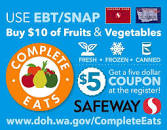What are food prescriptions?
Physicians write prescriptions for medications to help cure illnesses. Recently, doctors and other health professionals have begun writing food prescriptions to encourage people, particularly those in limited financial means, to buy and eat healthy foods. The Food Insecurity Nutrition Incentive Grant Program in the US Department of Agriculture supports projects that encourage people to eat more fruits and vegetables. The State of Washington Department of Health used USDA grant funding to develop and oversee a four-year program to offer fruit and vegetable vouchers to participants in the Supplemental Nutrition Assistance Program. The program operated through 169 retail outlets of a supermarket chain in counties with disproportionate numbers of low-income residents. Fourteen local partner organizations (health centers, clinics, local health departments, hospitals) identified potential recipients of $10 paper vouchers redeemable for fresh, frozen, or canned fruits and vegetables.
Over the first two years of operation, the program distributed 24,481 food prescription vouchers worth $284,810 to 3,688 unique shoppers. Participants redeemed 54 percent of the vouchers. Voucher recipients reported that the vouchers were easy to use and that the vouchers increased fruit and vegetable intake, increased the variety of fruits and vegetables they ate, and fostered better health. Partner organizations reported difficulty in tracking the distribution and use of the paper vouchers. Overall, the healthy food voucher program was scalable, applicable to a variety of patient encounters, and effective in boosting fruit and vegetable consumption.
How much would food prescription programs increase fruit and vegetable intake?
The idea of health care professionals writing prescriptions for healthy food has grown considerably over the past 5 years. In 2021, researchers conducted a systematic review and meta-analysis of relevant studies. The 13 studies included mostly pre- and post-evaluations without control groups. The included studies provided monetary subsidies or direct provision of fruits and vegetables. Pooled estimates of data from 1,039 participants showed a significant 22 percent increase in fruit and vegetable consumption, equating to an average daily increase of 0.8 servings. In addition, body-mass index declined significantly by 0.6 kg/m2, while HbA1c declined by 0.8 percentage points. Alas, the included studies often suffered from methodological shortcomings, such as lack of control groups, small numbers of participants, and short duration. Nonetheless, the apparent initial success of healthy food prescriptions warrants large, well-designed, rigorously controlled trials to better understand the potential of healthy food prescriptions to improve diets and cardiometabolic health of low-income people.
Researchers in Canada conducted a scoping review of food prescription programs to find out if food prescriptions work as intended. Their review included 23 studies designed to increase fruit and vegetable consumption and/or reduce food insecurity. All but one of the included studies dated from 2015, showing the recent vintage of food prescription programs. Food prescriptions were administered in a variety of settings, by a variety of health professionals, to a variety of low-income participants. The programs usually focused on increasing fruit and vegetable intake via vouchers but also included pre-assembled food boxes or access to food pantries or discounts at a partner retail store. The food prescription programs usually reported improved affordability and accessibility of healthy foods, especially fruits and vegetables, by participants. Few of the studies reported health impacts, and those results were mixed. The studies suffered from several shortcomings that limited the ability to draw firm conclusions from the results. Sample sizes of participants were generally low with a median size of 48 participants. Studies tended to be small pilot projects that lacked a control group or relied on self-reports of healthy food intake or health outcomes. Nevertheless, food prescription programs offer promise to increase the consumption of healthy foods by low-income people.
Do food prescription programs promote better health?
Eating lots of fruits and vegetables comprises a cornerstone of a healthy diet. Most Americans do not eat the recommended 5-6 cups of fruits and vegetables per day. This disparity increases for low-income people with food insecurity. Programs that include health professionals prescribing increased consumption of fruits and vegetables and financial support for low-income people to purchase more fruits and vegetables have been initiated across the US. A new study from Tufts University evaluated the effectiveness of nine such programs in terms of changes in fruit and vegetable consumption and several other measures of better health. The programs ran from 4-10 months, included adults (average age 55 years) and children (average age 9 years), and provided an average of $43 per adult and $112 per child per month.
Compared to baseline, fruits and vegetable intake increased significantly by 0.85 and 0.26 servings per day for adults and children, respectively. For adults, clinical biomarkers of cardiometabolic health improved by statistically and clinically meaningful amounts for HbA1c, systolic and diastolic blood pressure, and body mass index. In addition, the odds of being food insecure declined significantly, while the odds of better self-rated health improved significantly. Thus, the included food prescription programs did what they were supposed to do, namely increase fruit and vegetable consumption, reduce food insecurity, and foster better health of low-income people.





